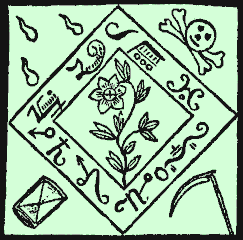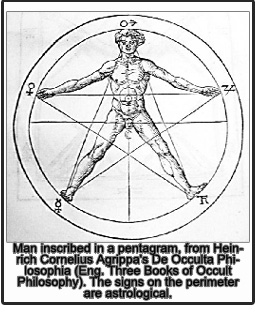 |

This design for an amulet comes from the Black Pullet grimoire. |
GrimoireSig and Professor Herman study Grimoires for possible Black Magic spells used by the Dark Mage. Find out a little more about these Wizards' tomes below. Grimoire ( /grim-war/) is a textbook of magic. Such books typically include instructions on how to create magical objects like talismans and amulets, how to perform magical spells, charms and divination and also how to summon or invoke supernatural entities such as angels, spirits, and demons. In many cases the books themselves are also believed to be imbued with magical powers, though in many cultures other sacred texts that are not grimoires, such as the Bible and Qur'an, have also been believed to intrinsically have magical properties; in this manner while all books on magic could be thought of as grimoires, not all magical books could. While the term grimoire is originally European, and many Europeans throughout history, particularly ceremonial magicians and cunning folk, have made use of grimoires, the historian Owen Davies noted that similar such books can be found all across the world, ranging from Jamaica to Sumatra, and he also noted that the first such grimoires could be found not in Europe but in the Ancient Near East. It is most commonly believed that the term grimoire originated from the Old French word grammaire, which had initially been used to refer to all books written in Latin. By the 18th century, the term had gained its now common usage in France, and had begun to be used to refer purely to books of magic, which Owen Davies presumed was because "many of them continued to circulate in Latin manuscripts." However, the term grimoire also later developed into a figure of speech amongst the French indicating something that was hard or even impossible to understand. It was only in the 19th century, with the increasing interest in occultism amongst the British following the publication of Francis Barrett's The Magus (1801), that the term entered the English language in reference to books of magic. In the Medieval period, the production of
grimoires continued in Christendom as well as amongst Jews and the
followers of the newly founded Islamic faith. As the historian Owen
Davies noted, "while the [Christian] Church was ultimately successful
in defeating pagan worship it never managed to demarcate clearly and
maintain a line of practice between An excerpt from Sefer Raziel HaMalakh, featuring various magical sigils (or seguloth, in Hebrew). With the increase in contact between Christians and Muslims through the Crusades and the Moorish occupation of Spain, various magical ideas and concepts originating in the Islamic world made their way into European grimoires. In particular, astral magic, involving invoking and praising the powers of celestial bodies into talismans and amulets was introduced to significant effect. One such Arabic grimoire devoted to astral magic, the 12th Century Ghâyat al-Hakîm fi'l-sihr, was later translated into Latin and circulated in Europe during the 13th century under the name of the Picatrix. However, not all such grimoires of this era were based upon Arabic sources; the 13th Century the Sworn Book of Honorius for instance was, like the ancient Testament of Solomon before it, largely based upon the supposed teachings of the Biblical king Solomon, and also included ideas such as prayers and a ritual circle, with the mystical purpose of having visions of God, Hell and Purgatory, and gaining much wisdom and knowledge as a result. Another was the Hebrew Sefer Raziel Ha-Malakh, translated in Europe as the Liber Razielis Archangeli.
|
|
| Web Design by Mike Lance | |
 religious devotion and magic," and the use of
such books on magic continued. In Christianized Europe, the Church
divided books of magic into two kinds; those that dealt with "natural
magic" and those that dealt in "demonic magic". The former was
acceptable, because it was viewed as merely taking note of the powers
in nature that were created by God, for instance the Anglo-Saxon leech
books which contained simple spells designed for medicinal purposes
were tolerated. However the latter, demonic magic was not acceptable,
because it was believed that such magic did not come from God, but from
the Devil and his demons - these grimoires dealt in such topics as
necromancy, divination and
demonology. Despite this, "there is ample evidence that the medieval
clergy were the main practitioners of magic and therefore the owners,
transcribers, and circulators of grimoires" while several grimoires
were actually attributed to various Popes.
religious devotion and magic," and the use of
such books on magic continued. In Christianized Europe, the Church
divided books of magic into two kinds; those that dealt with "natural
magic" and those that dealt in "demonic magic". The former was
acceptable, because it was viewed as merely taking note of the powers
in nature that were created by God, for instance the Anglo-Saxon leech
books which contained simple spells designed for medicinal purposes
were tolerated. However the latter, demonic magic was not acceptable,
because it was believed that such magic did not come from God, but from
the Devil and his demons - these grimoires dealt in such topics as
necromancy, divination and
demonology. Despite this, "there is ample evidence that the medieval
clergy were the main practitioners of magic and therefore the owners,
transcribers, and circulators of grimoires" while several grimoires
were actually attributed to various Popes.